#eurybia macrophylla
Photo


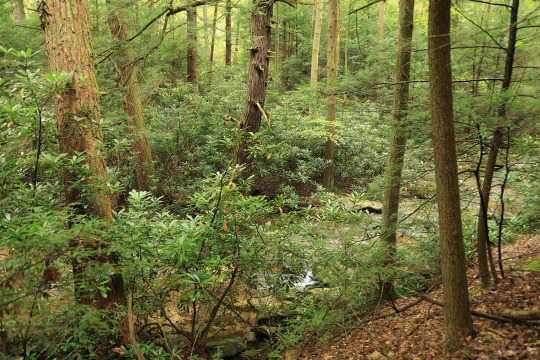

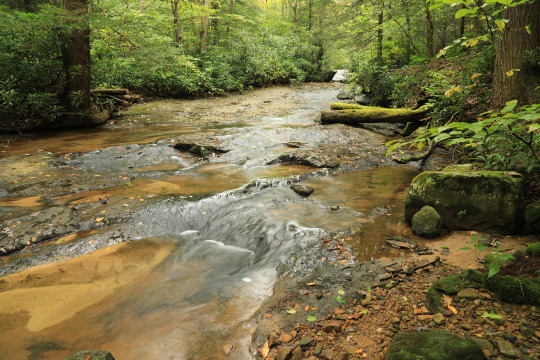
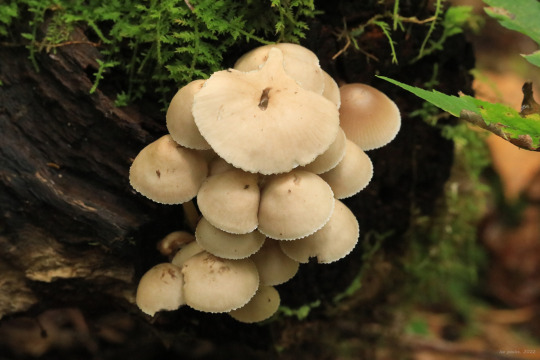


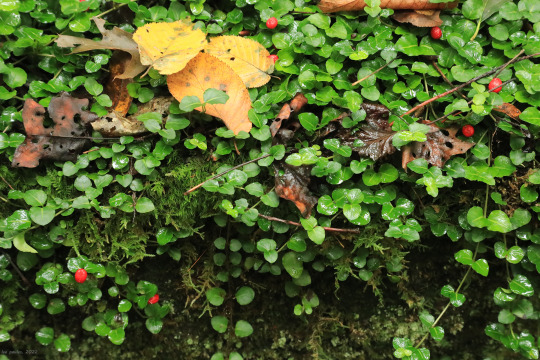
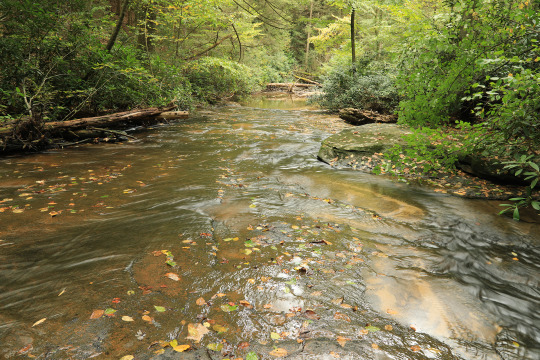
Walk with me: an early October stroll through the virgin hemlock forest along Little Laurel Run in Coopers Rock State Forest. The older I get the more I find myself drawn to animism. It’s so easy to walk in an old forest like this and imagine that everything in it - rocks, trees, moss - has been gifted with a sentient awareness. Not by some hateful, spiteful god, but by the grace of nature in her infinite wisdom.
#appalachia#vandalia#west virginia#coopers rock state forest#little laurel run#virgin hemlock trail#virgin hemlock forest#tsuga canadensis#eastern hemlock#canadian hemlock#lophocampa caryae#hickory tussock moth#hickory tiger moth#eurybia macrophylla#big-leaved aster#bigleaf aster#large-leaved aster#mitchella repens#partridgeberry#partridge berry#autumn#fall#wildflowers#flora#berries#fungi
264 notes
·
View notes
Text

Eurybia macrophylla, the bigleaf aster.
#Bruce Trail#West Rocks#Niagara Escarpment#Bruce Peninsula#Bruce County#Ontario#Canada#hiking#hiking trail#nature#forest#trees#wilderness#outdoors#landscape#Eurybia macrophylla#bigleaf aster#aster#flower#flora#vegetation#plants#photography#digital photography#DSLR#Canon 6D#photographers on Tumblr#2022-09-02
0 notes
Photo
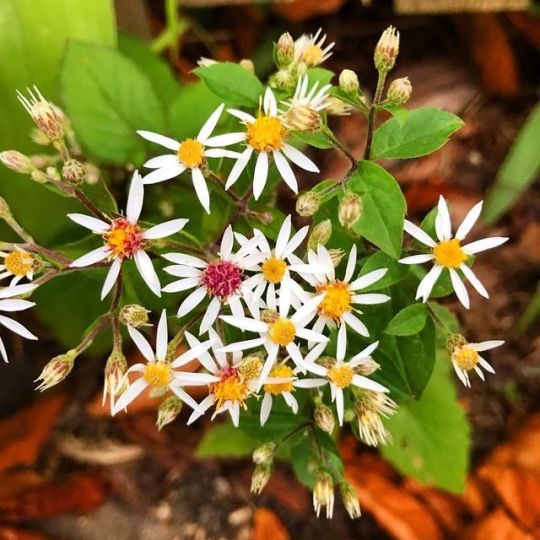
در ستایش #علف_هرز (ستارهای برگ پهن). On #weed appreciation (Large-Leaved Aster) #Eurybia macrophylla #medicinalplanets https://www.instagram.com/p/B2MORZchU4-/?igshid=h8asmxm6375
1 note
·
View note
Text
The Signs As Random Wikipedia Articles
Aries: Brian Widlake
Arsces: Bristol 409
Arrius: Viraboury District
Ariborn: Long Division (Low album)
Arittarius: Jack Rife
Arpia: Modern Woman
Arza: Sony Pal
Arga: Calcium citrate
Aro: 41st Air Division
Arcen: Transitional Federal Parliament
Armini: 1990 Estoril Open – Doubles
Arun: Trey Lunsford
Arist: Deulabari Union
Arsci: Sratsimir dynasty
Arnius: Nanyang Jiangying Airport
Aricorn: International Boat Industry
Arittanius: Suiticide
Arpio: Abu Jafar ibn Harun al-Turjali
Arra: Greta libethris
Argo: Los Pehuenches Airport
Arlo: Seroczyn, Sokołów County
Arcer: Triumphs of a Taxidermist
Armino: Alliance in the Alps
Arus: Anaconda Peak
Taurus: The Trinity Tripod
Taurist: Gerli Liinamäe
Taursci: Banka Junction railway station
Taurnius: Andrej Brázda-Jankovský
Tauricorn: Montenegro at the 2009 World Championships in Athletics
Taurittanius: 1900 in Costa Rica
Taurpio: Alf Poier
Taurra: Anthony Trethowan
Taurgo: Catarhoe
Taurlo: Fender Katana
Taurcer: Noorhaqmal Mohamed Noor
Taurmino: Pech Chenda
Taurun: Mercer County Courthouse (Illinois)
Tauries: Mowchadz’ River
Taursces: Khidima
Taurrius: GMA Network (company)
Tauriborn: Qingdao Technical College
Taurittarius: Wilkingia
Taurpia: Strength of the Sword 3
Taurza: Media in Portland, Maine
Taurga: Radhouane Chebbi
Tauro: Soy egg
Taurcen: John Evans (rugby player)
Taurmini: Trinity Congregational Church, Arundel
Gemini: Danske Bank (Norway)
Gemun: 1964–65 SM-sarja season
Gemries: Alusian of Bulgaria
Gemsces: Lantau Link
Gemrius: Orlyane
Gemiborn: Calcipressin
Gemittarius: Franchi SPAS-15
Gempia: Neusiß
Gemza: United Nations Security Council Resolution 75
Gemga: Flavelle
Gemo: Bhagirathipur, Dhenkanal
Gemcen: Richard Marsina
Gemino: 5th Royal Bavarian Division
Gemus: Duncan Cooper (footballer)
Gemrist: Belle Rive, Illinois
Gemsci: 2010–11 Danish Superliga
Gemnius: Songs and Tunes from the Original Soundtrack of Magical Sentosa
Gemicorn: The Twa Sisters
Gemittanius: Czarne, Gołdap County
Gempio: Osric, king of the Hwicce
Gemra: Francis Phips
Gemgo: Luttrell's Tower
Gemlo: Sean Clohessy
Gemcer: United Press International Athlete of the Year Award
Cancer: Strumigenys nanzanensis
Camino: Udall, Missouri
Canus: Robert Montague (Jamaican politician)
Canrist: 2017 Liga 3 South Sumatra
Cansci: Petr Pavlensky
Cannius: Hugh Tootell
Canicorn: Hamersley Range
Canittanius: Visa requirements for Somaliland citizens
Canpio: GLKS Nadarzyn
Canra: 1978 Speedway World Team Cup
Cango: Barasat
Canlo: Vladimir Lossky
Cancen: Otto Miguel Cione
Camini: Arrow 3
Canun: Victor Bumbalo
Canries: Moritz Kaposi
Cansces: Heartbeat (1993 film)
Canrius: Chan Sui Ki (La Salle) College
Caniborn: Martin C. Ansorge
Canittarius: Arctic Trucks
Canpia: Indexicality
Canza: Index of Cape Verde-related articles
Canga: Ryan Hanigan
Cano: Milena Milašević
Leo: Appouasso
Lecen: Baron Aldenham
Lemini: Purdue Polytechnic Institute
Leun: Watsessing Avenue station
Leries: Bardastemal
Lesces: San Lucas Ojitlán
Lerius: W. Avery & Son
Leiborn: Prague Zoo
Leittarius: One L
Lepia: Maryland Terrapins women's basketball
Leza: Travel Trendz
Lega: Esteban Loaiza
Lelo: List of foreign observers of Russia
Lecer: Sebastián Arrieta
Lemino: Legislative districts of Cotabato
Leus: Ward Valley
Lerist: Roy Curry
Lesci: Ollie Johnson (basketball, born 1949)
Lenius: Epifanio Comis
Leicorn: Namgen
Leittanius: Bristol Crown Court
Lepo: Vladimir Cruz
Lera: Public float
Lego: Chi Kraeng District
Virgo: Sturisoma frenatum
Virlo: Henley Rural District
Vircer: White Oak, Ritchie County, West Virginia
Virmino: Ribes watsonianum
Virus: Westwood (subdivision), Houston
Virist: Strâmbișoara River
Virsci: John Merritt (baseball)
Virnius: Bras d'Eau National Park
Viricorn: Masarjawaih
Virittanius: Guatemalan Act
Virpio: Don Fumino
Virra: Chymase
Virga: James Steel House
Viro: Seychelles Marketing Board
Vircen: Zend Framework
Virmini: Idol Camp
Virus: Open Books & Records
Viries: Inner Banks
Virsces: Chronica Gallica of 511
Virrius: Murzynowiec Leśny
Viriborn: The Mute of Portici (1922 film)
Virittarius: Jenny Laird
Virpia: Abe Manley
Virza: Flag of Merionethshire
Libra: John Gallagher (rugby league)
Ligo: Subaru G
Liblo: Funky Miracle
Licer: List of current standing members of the National People's Congress
Limino: 42nd Saturn Awards
Libus: Mary Cuddie
Librist: Daxing Line, Beijing Subway
Libsci: Takehiko Shinjō
Libnius: Lachhi (1949 film)
Libicorn: Harold Gillies
Libittanius: Paulo Miklos
Lipio: Da Ya Think I'm Sexy?
Libza: Aston Business School
Liga: Xestia badicollis
Licen: Arrow Creek (Fergus County, Montana)
Limini: M. Chandrasekaran
Libun: Colorado State Highway 172
Libries: Coach of the Year Trophy (IHJUK)
Libsces: 1929 college football season
Librius: Gamla Turingevägen Inscriptions
Libiborn: Rock concert
Libittarius: Herat Province
Lipia: Discovery Limited
Scorpio: Oslo Airport, Gardermoen
Scorra: Victor Crowley (film)
Scorgo: Mallakhamba
Scorlo: Oliver Skeete
Scorcer: Raquel Giscafré
Scormino: 2014 CERH European Roller Hockey U-17 Championship
Scorus: Cap Djinet
Scorist: Jubilee Hospital, Huntly
Scorsci: NASA Authorization Act of 2005
Scornius: Virginia Beach Open
Scoricorn: Amon Düül UK
Scorittanius: Alkb homolog 3, alpha-ketoglutaratedependent dioxygenase
Sorpia: Campagnac, Tarn
Scorza: Tozeur–Nefta International Airport
Scorga: Frederick Talbot
Scoro: Municipality of Duplek
Scorcen: Deric Yaussi
Scormini: The Chronicles of Narnia: The Lion, the Witch and the Wardrobe
Scorun: Church Music Association of America
Scories: Watkins Family Hour
Scorsces: Gentle Bones discography
Scorrius: Lincoln, Pennsylvania
Scoriborn: Ozurgeti Municipality
Scorittarius: Neurophyseta renata
Sagittarius: Neu-Anspach
Sagipia: Iron Belle Trail
Sagiza: Virginia gubernatorial election, 1905
Sagiga: Fleckvieh
Sagio: Ezzat Jadoua
Sagicen: Benderama
Sagimini: Karla Boddy
Sagiun: Cook County Board of Commissioners
Sagiries: Solium Infernum
Sagisces: Pacitan Regency
Sagirius: William Patterson Dunlop
Sagiborn: Dennis Olson (fighter)
Sagittanius: Sphenoidal emissary foramen
Sagipio: Mary Killman
Sagira: 2 (The Black Heart Procession album)
Sagigo: 1952 Slovenian Republic League
Sagilo: Sand Museum
Sagicer: 1983 VFL season
Sagimino: Chieko Asakawa
Sagius: Auction sniping
Sagirist: List of prefects of Vukovar-Srijem County
Sagisci: Erythroecia
Saginius: Discovery Science (Canada)
Sagicorn: Paliseul
Capricorn: Antonio Montella
Capritannius: Luke's Preparedness Preparations
Capripio: Amzath Khan
Caprira: Tropical Storm Henri (2003)
Caprigo: Julia Elliott
Caprilo: Robert Hecht-Nielsen
Capricer: Mottai Night Land
Caprimino: Baydu
Caprius: Bryant Terry
Caprist: Lake Elizabeth Township, Kandiyohi County, Minnesota
Caprisci: Yale World Fellows
Caprinius: Eurybia macrophylla
Capriborn: Alec Troup
Caprittarius: Georges Mandjeck
Capripia: Lipa, Zreče
Capriza: West Virginia League
Capriga: Cyclical theory
Caprio: Canada (1967 song)
Capricen: Natalie Dianová
Caprimini: The Gambler (1938 film)
Capriun: Lalanam
Capries: James M. McMichael
Caprisces: Luke Doran
Capririus: Raees Dynasty
Aquarius: Alina Vergara
Aquiborn: Tristan Tafel
Aquittarius: Barthélémy Djabla
Aquapia: M'hamed Bougara University of Boumerdès
Aquaza: Now Jub
Aquaga: Bill Morris (basketball)
Aquo: Thomas M. Carlson
Aquacen: Sassona Norton
Aquamini: La Hoya, Alava
Aquiun: Mount Antero
Aquaries: Haute-Vigneulles
Aquasces: Mahmud Nedim Pasha
Aquanius: A Certain Magical Index: The Movie – The Miracle of Endymion
Aquicorn: WBZG
Aquittanius: Scarborough Formation
Aquapio: Louit
Aquara: Astra Edwards
Aquago: Glochidion moonii
Aqualo: San Diego High School (Texas)
Aquacer: Richmond Town Hall
Aquamino: Manuel Zarzo
Aquius: Pectinivalva gilva
Aquarist: Mirusha Park
Aquasci: 2006 PBA Philippine Cup
Pisces: Rillettes
Pirius: Taihei Imamura
Piborn: Human Flame
Pittarius: Hoover Cyclecar
Pipia: Triplostephanus hoaraui
Piza: Gmina Zalewo
Piga: Qatar at the Paralympics
Pio: Emmanuel College, University of Queensland
Picen: Kılıçkaya
Pimini: Jauni
Piun: Ventura County Fusion
Piries: Jalan Bota Kiri
Pisci: Inquisitor hormophorus
Pinius: Wiraqucha (Junín)
Picorn: Brian Ross (footballer)
Pittanius: Dicranopteris
Pipio: Génova, Quetzaltenango
Pira: You Were Meant for Me (film)
Pigo: Anita Municipal Airport
Picer: Desmia validalis
Pimino: Selfors
Pius: Timaru District
Pirist: All India Kashmiri Samaj
#i'm fucking pissed i spent like a week carefully linking every single one but apparently it doesn't work#i guess it was too many links? or tumblr is just broken#homestuck#hiveswap#true sign#the signs as
28 notes
·
View notes
Text
Plants Native to Tennessee: Flower Edition
This is just going to be an info dump of different plans and herbs that grow in my area. It’s always frustrating to see all of these posts requiring certain kinds of herbs or flowers that I just don’t have access to. Hopefully other people in Appalachia can make use of this as well.

Bear Grass (also known as: Adam’s Needle) -
Species: Yucca filamentosa
Scattered lightly across the state, excluding in the northeast corner of Tennessee.
Correspondences: innocence, humility, reverence, purity, rejuvenation, travel, astral travel, knowledge, understanding, harmony, spirit communication, protection, telepathy, faith, consistency, mental clarity, optimism.
Uses: There is some evidences that Yucca plants can be used for high cholesterol, arthritis, high blood pressure, migraines, digestive disorders, diabetes, poor blood circulation, skin problems, and other conditions. (For dosages, side effects, and medication interactions, visit WebMD.)
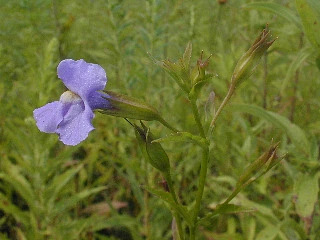
Allegheny Monkey Flower
Species: Mimulus ringens
This flower grows wildly in Blue Ridge, Ridge and Valley, and Cumberland Plateau regions
Correspondences: Femininity, growth, representative of the Maiden, elegance, grace, and the Fae.
Uses: I have been unable to find any medicinal and culinary uses for this plant. If you know or comes across any practical uses for it, please message me!

Allegheny Spurge
Species: Pachysandra procumbens
These flowers are found in Middle and East Tennessee
Correspondences: Change, new opportunities and beginnings, upward bound, successful endeavours, and representative of the Smoky Mountains.
Uses: Ornamental **TOXIC**

American Columbo (also: Green Gentian)
Species: Frasera caroliniensis
Found mostly in Middle Tennesse; can be found sprinkled lightly in West and East Tennessee.
Correspondences: Nature, growth, harmony, freshness, fertility, and safety.
Uses: The root of this plant can be used to make a tonic. There isn’t evidence of medicinal use.

American Ginseng
Species: Panax quinquefolius
These plants can be found across the entire state.
Correspondences: Passion, love, passionate love/lovers, seduction, danger, anger, adventure, fire, blood, nature, fertility, freshness.
Uses: This plant may be used to reduce inflammation, possibly beneficial to brain function, possible improvement for those with erectile dysfunction, boost the immune system, may fight fatigue and increase energy levels, and possibly lower blood sugar. (Research dosages, side effects, and medication interactions before using.)
***This shouldn’t need to be said but it does (based on the amount of tourists that I’ve seen that do this): IF YOU ARE IN THE GREAT SMOKY MOUNTAIN NATIONAL PARK OR ANY OTHER PARK DO NOT TAKE THESE PLANTS OR ANY OTHERS***

American Lotus
Species: Nelumbo lutea
These are found in the Gulf Coastal Plains of Tennessee (West Tennessee).
Correspondences: Purity, innocence, representative of The Maiden, fertility (can also be used as a symbol of virginity due to the fact that it has white petals).
Uses: Leaves, stalks, root stocks, and seeds may be eaten.
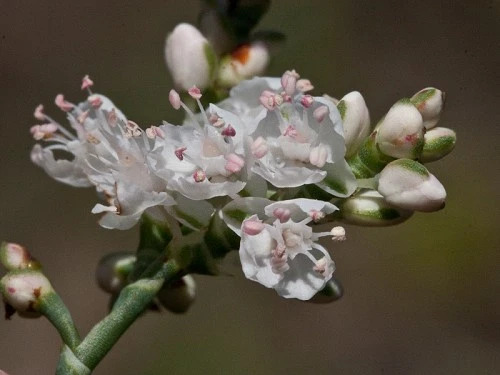
American Jointweed (also: Southern Jointweed)
Species: Polygonella americana
This flower is found ONLY in Morgan County (which is in East Tennessee). It is also an **ENDANGERED SPECIES** so obviously, if you come across this flower do NOT collect it under any circumstances.
Correspondences: innocence, fertility, virginity, feminine energies, delicacy, nostalgia, and romance.
Uses: I will not list the uses for the American Jointweed to prevent the temptation to collect this flower.
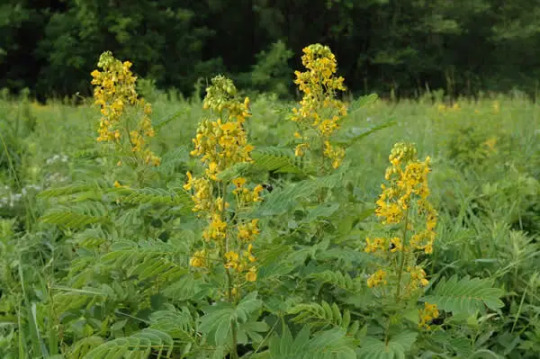
American Senna (also: Wild Senna)
Species: Cassia hebecarpa
This plant is most easily located in the eastern Blue Ridge and Ridge and Valley areas; however, it can also be found in smaller amounts in Middle, East, and West Tennessee.
Uses: Modernly, the plant is mostly ornamental. However, the Cherokee used Wild Senna in various infusions, concoctions, and salves to treat cramps, heart troubles, fevers, as a purgative, sores, and pneumonia. (Again, investigate before consuming.)
Correspondences: Joy, friendship, happiness, new beginnings, nature, safety, health, excitement, enthusiasm, boldness, brightness, intelligence, communication, travel, astral travel, knowledge, understanding, harmony, spirit, protection, telepathy, faith, consistency, mental clarity, optimism.
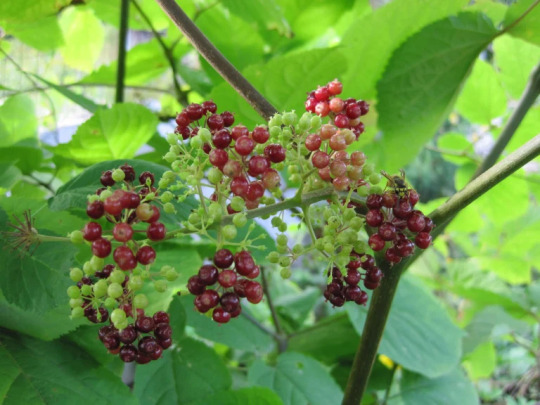
American Spikenard
Species: Aralia racemosa
This plant is most commonly located in East Tennessee, and more sparsely in Middle and West Tennessee.
Uses: This plant has been used for coughs, catarrh, tuberculosis leucorrhoea, prolapse of the uterus, and chlorosis.
Correspondences: Royalty, luxury, power, ambition, dreams and plans coming to fruition, new beginnings, new life.
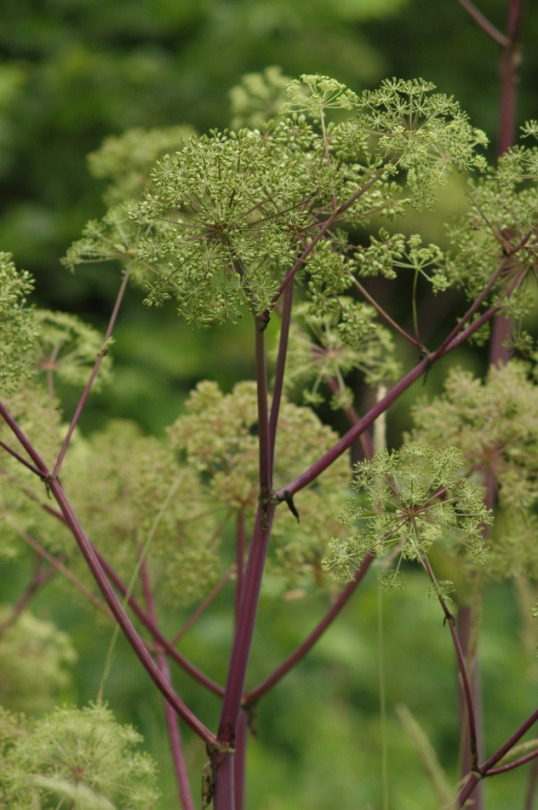
Angelica
Species: Angelica atropurpurea
This plant is only found in Johnson and Unicoi counties in the Blue Ridge Province.
Uses: The stems are edible (apparently some people make candy from the stems?? Not sure if that’s something I would personally do, but neat nonetheless). It is often used as a tonic, digestive aid, and treatment for chest complaints, anemia, and bronchitis. Teas and compresses can be made from the leaves.
Correspondences: Stability, ferocity, lovers, relationships, passion, passionate lovers and relationships, boosts sex life, independence, mystery, emotional vulnerability.
(Research properly before consuming. Yes, I will type this after nearly every entry. I ain’t trying to have someone go off on me because they’ve made themselves sick.)

Appalachian False Goat’s Beard
Species: Astilbe biternata
This flower grows mostly in East Tennessee, however, it also occurs sparsely in Middle Tennessee.
Uses: None found. Simply a perennial and decorative flower.
Correspondences: The fae, purity, purification, innocence, honesty. inspiration, money/finances, nature, prosperity, success.
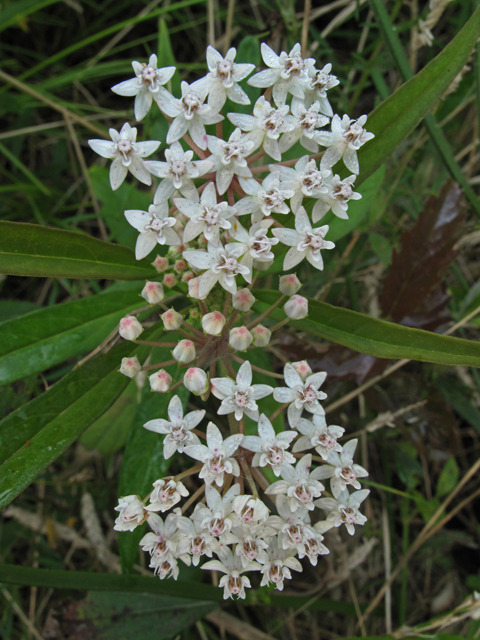
Aquatic Milkweed (also: Swamp Milkweed)
Species: Asclepias perennis
This flower is mostly found in West Tennessee.
Uses: This plant is **TOXIC **
Correspondences: Innocence, purity, purification, the broken link between human beings and the natural world, and reconnection.
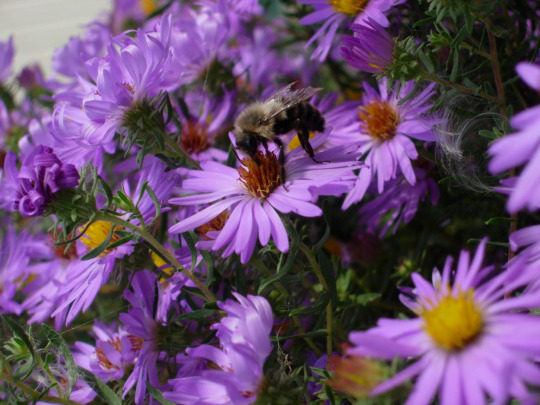
Aromatic Aster
Species: Symphyotrichum oblongifolium (Aster oblongifolius)
This flower is located sparsely in Middle and East Tennessee.
Uses: The only uses I found for this flower wasn’t able to be verified so what you’ll read next HAS NOT BEEN VERIFIED, DO YOUR OWN RESEARCH; you may find things I couldn’t. According to the one thing I’ve found, the roots could possibly be turned into a tea and consumed to treat fever.
Correspondences: Stars, the universe, the cosmos, ascension, success, springtime, hard work, the Goddess, regret, sorrow.

Arrowhead (also: Duck Potato)
Species: Sagittaria latifolia
This flower can be found is light amounts all over the state.
Uses: Tubers can be eaten in raw and cooked form; a poultice made from the leaves can be used to stop milk production; a tea from the roots can be used as a digestive aid; a poultice made from the roots can help treat wounds and sores.
Correspondences: Birds (specifically geese), purity, innocence, virginity, humility, gentle demeanor, happiness, happiness in friendships, joy, an aid for evocation of the God/Goddess(es).
Research this before consuming or applying to skin

Ashy Sunflower (also: Downy Sunflower)
Species: Helianthus mollis
This flower is native to Middle and West Tennessee
Uses: I wasn’t able to find uses for this particular species of sunflower. There are many uses for the common sunflower ( Helianthus annuus), however, I don’t know if their uses apply here. Research before consuming or applying to skin.
Correspondences: The sun, solar deities, positivity, joy, happiness, brightness, air, communication, travel, astral travel, knowledge, understanding, harmony, spirit communication, protection, telepathy, faith, consistency, mental clarity, optimism.

Barksdale’s Trillium (also: Furrowed Wakerobin, Sulcate Toadshade)
Species: Trillium sulcatum
This plant can be found in the Cumberland Plateau and the Ridge and Valley provinces.
Uses: The leaves can be cooked. The root can be used for an antiseptic, antispasmodic, diuretic, emmenagogue (to promote menstration), and ophthalmic uses. The roots can be used dry or boiled in milk (I’m sure milk substitutes could be used, but I’m not positive on that).
Correspondences: Love, violence, passion, purification, lust, amplifies energies, joy, luck, and confidenlce.


Barren Strawberry (also: Appalachian Barren Strawberry)
Species: Waldsteinia fragarioides
This plant is lightly scattered in East Tennessee.
Uses: A decoction can be made from this plant that is supposedly a blood remedy; a poultice made from the smashed plants. has been used on snakebites. (Treatments made from this plant are not a replacement for actual Medical Care.)
Correspondences: Symbolic of Venus - Goddess of Love, perfection, righteousness, purifying, love magick, blood magick, courage, power.
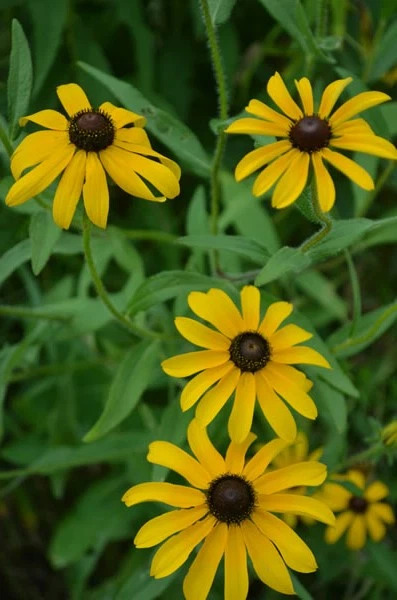
Biennial Black-eyed Susan
Species: Rudbeckia hirta
This flower can be found all over the state.
Uses: The roots of this plant are allegedly used to boost metabolism; it treats, the flu, colds, infection; snakebites, worms (in children) **THIS PLANT IS TOXIC TO CATS.**
Correspondences: Cleansing, releasing, grounding, meditation, spirit communication, joy, happiness, happiness within the darkness.

Big Leaf Mountain Mint (also: Short-Toothed Mountain Mint and Clustered Mountain Mint)
Species: Pycnanthemum muticum
Mostly found in Middle Tennessee and Blue Ridge regions.
Uses: Can be made into a tea or used as a substitute for mint in cooking
.Correspondences: Royalty, mysticism, mystery, the supernatural, cleanliness, a new slate, forgiveness.

Big-leaved Aster
Species: Eurybia macrophylla (Aster macrophyllus)
These are primarily found in the Eastern Blue Ridge region.
Uses: Larger, young leaves can be cooked and eaten as greens. It has also been used to treat blood disorders, loosening of the bowels (the roots are made into a decoction), treatment of headaches; burning this plant is supposed to attract deer.
Correspondences: Mystery, spirit magick, spirituality, mysticism, the supernatural.

Birdsfoot Violet
Species: Viola pedata
This flower is found statewide aside from the western boundary of Tennessee.
Uses: Poultices made from this plant are used to treat headaches and boils; infusions have been used to treat dysentery, colds, and coughs.
Correspondences: Femininity, death, faithfulness, healing, love, nymphs, peace, protection, rebirth, wishes.

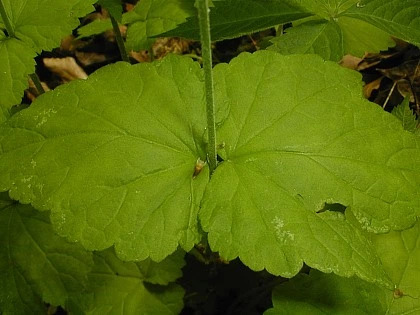
Bishop’s Cap (also: Miterwort and Twoleaf Miterwort)
Species: Mitella diphylla
This plant is mostly found in Middle and East Tennessee.
Uses: Ornamental.
Correspondences:
References:
https://www.avogel.ca/en/plant-encyclopedia/aralia-racemosa.php#:~:text=History,of%20the%20uterus%20and%20chlorosis.
https://en.wikipedia.org/wiki/Senna_hebecarpa#:~:text=They%20use%20a%20poultice%20the,compound%20decoction%20as%20a%20laxative.
https://www.teleflora.com/floral-facts/flower-color-meaning?promotion=JULYWELCOME5
https://tynnativeplants.wordpress.com/flowers/common-name/adams-needle-bear-grass/
https://ag.tennessee.edu/tnyards/Pages/The-Benefits-of-Native-Plants.aspx
0 notes
Photo

ビッグリーフアスター。大きな葉をもつシオン属の植物です。北米原産で日本ではなかなかお目にかかれません。 Bigleaf Aster (Eurybia macrophylla) (Solomon R. Guggenheim Museum) https://www.instagram.com/p/B1bKbdyAnR8/?igshid=1r6t3z2m45hne
0 notes
Text
Plants & Flowers Producing True Honey
Flowers & Plants Attracting Bees
Pansies
Whimsy, joy, colours – pansies have it all, and bees love them. They are great for containers or ground cover.
Pussy Willow
These North American wetland shrubs have a beautiful greyish hue and fur-like blooms.
Siberian Squill
These beautiful blue blooms have a stunning presence that you can enjoy for a few weeks each year.
Snowdrops
Snowdrops are known to announce their arrival by poking out of the snow. They are great for climates with mild to cold winters.
Peony
With their colours and sweet scents, these flowers will attract bees, hummingbirds, and possibly your neighbours too.
Milkweed
Milkweed not only serves as food to bees, but it is also the only host to monarch butterflies.
Bee Balm
As you may guess from the name, bees love these North American prairie flowers. The blooms almost resemble little fireworks and come in befittingly vibrant shades too.
Lavender
Bees love them for their nectar, humans love them for their scent and flavour. Everyone wins, and with many different varieties of lavender to choose from, you’ll likely find one that will settle happily in your garden.
Phlox
With their star-shaped blooms, these plants are a beautiful addition to any garden and can make a great ground cover.
Zinnias
Zinnias come in many colours and will attract both bees and butterflies to your space. They are relatively easy to plant and will bloom in abundance all summer long if dead flowers are removed.
Marigolds
Like zinnias, marigolds are annuals that can bloom all summer long if properly groomed. Their edible blooms can brighten up your salads as well as your garden, and they are even known to repel pests and animals, such as nematodes.
Goldenrod
These flowers are sometimes considered weeds because of their ability to spread easily but kept in check, they are an invaluable resource for bees and have medicinal value as well.
Chives
Resist eating their tasty purple flowers and the bees will thank you! This perennial tolerates cold climates rather well and is a great way to add a fresh, oniony taste to salads, dishes, or eggs.
Liatris
These flowers, found in purple, pink, and white, bloom on grass-like spiky leaves that can grow 1 – 5 feet tall.
Mint
Mint is invigorating with its fragrance and flavour – and bees go crazy on their flowers too. Mint is a great choice if you’re looking for a herb that’s low maintenance.
Sage
It’s great in stuffing, sauces, and herb pots! Bees love sage’s beautiful flowers, and these perennials are rather easy to grow.
Nasturtium
Nasturtiums can keep bees buzzing in your garden well into autumn. Their edible blooms will bring a burst of colour to your outdoor space.
Black-eyed Susans
These are flowers that attract bees, butterflies and bring a burst of yellow to your garden.
Borage
Also known as starflower, borage’s star-shaped blooms start out pink and mature into a beautiful blue.
Thyme
Irresistible to bees and pun-lovers alike, placing one of these shrubs by a walkway will prove to be a wonderful way to pass the thyme.
Oregano
This perennial has pink, purple, or white flowers, and its late blooms will be appreciated by your bee friends.
Calendula ~ Calendula officinalis
Shorter, bushy plants full of orange/yellow, daisy-like flowers that provide both pollen and nectar for pollinators.
Salvia
Description: The term “salvia” includes a massive group of plants, with something like 800 or 900 different species! Culinary sage is salvia too.
Nasturtium ~ Tropaeolum
Description: Easy to grow, sprawling, edible, lovely nasturtium! The peppery arugula-like leaves are edible, as well as the flowers. The blooms come in a variety of colours.
Verbena ~ Vervain
Description: Verbena is a huge family that includes over 250 species of both annual and perennial plants. Most of them produce flowers that pollinators go wild for!
Hyssop ~ Agastache
These tall showy, long-lasting spikes full of hundreds of individual blooms are essential in a pollinator garden! Also called “hummingbird mint”, they’re a favourite nectar source for our sweet little bird friends.
Heliotrope ~ Heliotropium
Description: These fairly compact plants range from 1 to 3 feet high, with dark green fuzzy foliage. The plants produce very fragrantly, vanilla-scented flowers.
Yarrow ~ Achillea
Description: Clusters of small yellow, pink, white, red, or lavender flowers. One of our favourite varieties is “Moonshine” yarrow, which has silvery-sage, fuzzy foliage.
Blazing Meadow Star ~ Liatris
Blazing Meadow Star is a known “monarch magnet”. These perennial plants can reach over 4 feet tall.
Penstemon
Penstemon range from less than a foot tall to over 5 feet tall. The nectar-rich flowers also come in a wide range of colours, shapes, and sizes.
Pincushion ~ Scabiosa
Round, frilly, tufted flowers that appear in lavender, blues, pink and white. Most varieties are short, averaging around a foot tall. Both annual and perennial varieties exist.
Bachelor’s Buttons ~ Centaurea
Their 2” thistle-like blooms bring interest to the garden, attract butterflies, are edible, and are perfect for cut and dried flower arrangements.
Anise hyssop/Agastache foeniculum
Anise hyssop is considered one of the premier plants for feeding pollinators. One can see bees on the flowers from the morning until dusk.
Astilbe, False spirea/Astilbe spp.
Astilbes are excellent at creating soft, colourful displays underneath trees, in low light corners, or in shady borders.
Chrysanthemum (open types)/Chrysanthemum
Gardeners and councils who want to plant the right flowers to attract bees usually choose them based on how easy they are to plant, and by watching which ones the insects already visit.
Betony/Stachys Monieri
This species forms large, rounded clumps of green, long and narrow, textured leaves. It is lovely even when it's not in bloom.
Blanket flower/Gaillardia
This is a species that is nourished by neglect, and that thrives in sunny, dry, and rocky conditions.
Clematis/Clematis spp.
Clematis stans are dioecious semi-arboreal, with pale purple-blue, nodding, tubulous flowers in a paniculate inflorescence. Both male and female flowers produce nectar from the base of the calyx tube during a flowering period of 3 or 4 days and are pollinated by two bumblebee species.
Common poppy, Red poppy/Papaver rhoeas
A must-have for any wildflower meadow or garden, this easy-to-grow annual delights with bright blooms throughout the summer season.
Common yarrow/Achillea millefolium
Yarrow attracts butterflies, bees and other insects, making it a nice addition to a pollinator garden.
Coral bells/Heuchera spp.
Annual flowers like coral bees are readily available at the garden centre, but most have been bred for showy flowers or vigorous growth and do not produce enough pollen and nectar to be good food plants for bees or butterflies.
Fennel/Foeniculum vulgare
This perennial herb is a member of the carrot family and originally comes from the Mediterranean.
Foxglove or beardtongues/Penstemon spp.
They are tubular in shape and about 1" long, with the corolla, divided into a lower lip with 3 lobes and an upper lip with 2 lobes.
Globe thistle/Echinops ritro
Echinops, the blue hedgehog thistle or globe thistle, is a perfect sphere of blue that appeals to every pollinator around.
Hyssop (naturalized in North America)/Hyssopus
officinalis Hyssop (Hyssopus officinalis) Labiatae, is a compact, bushy perennial usually grown in herb gardens, but is great in flower gardens in masses, as a hedge or border, and in pots. Because of its medicinal smell Hyssop has a history as a cleansing herb that attracts a bee.
Large-leaved aster/Eurybia Macrophylla
Asters and goldenrods attract loads of late-season pollinating insects. In the wintertime, they provide food and habitat for many birds and small animals that feast on the seeds and find shelter in the dried stalks.
Allium
Many garden varieties are available, these are bulb forming perennials. Some are very showy, with huge flower heads.
Antirrhinum, snapdragon
Like their relative the foxglove, mainly visited by long-tongued bumblebees such as B. hortorum. Short-lived perennials, often grown as annuals.
Apple
Apples are a good source of forage for queens in April and May, and of course, the bee visits ensure a good crop. owers and are very attractive.
Aquilegia
Nectar is hidden at the end of very long tubes, so it is visited by long-tongued bees.
Bistort
A very tough, spreading, low growing perennial. Good ground cover. A bit hit and miss with bees, but seems popular with Bombus hypnorum in particular.
Buddleia davidii, Butterfly Bush
A fast-growing shrub, to 9', great nectar source for butterflies and popular too with bumblebees. I often see young queen Bombus Terrestris on this, fattening up before going into hibernation in July/August.
Cirsium rivulare
A great one for male bumblebees in high summer, this species is not spiny like its wild relatives and is quite at home in a herbaceous border.
Comfrey, Symphytum officinale
Visited by long and short-tongued species, the latter often robbing from holes bitten in the tops of the flowers.
Cotoneaster horizontalis
Favoured by short-tongued species such as the early bumblebee, B.pratorum, and the tree bumblebee, B.hypnorum.
Crocus
Great for queens when just emerged from hibernation. Joan of Arc comes highly recommended.
Echinops, Globe thistle
Pretty and unusual perennial, with mauve flowers producing spiky balls on tall sturdy stems in high summer.
Echium vulgare, Viper's bugloss
A stunning biennial wildflower growing to about 4', flowering in July and August and absolutely loved by bees of all types for its copious nectar.
Foxglove, Digitalis purpurea
No cottage garden is complete without foxgloves, hardy biennials that are loved by long-tongued bees such as B.hortorum and B.pascuorum.
Geranium spp.
Geraniums are hardy perennials that come in a broad range of colours, but most are moderately attractive to short-tongued bees.
Globe artichoke
Huge plants, related to thistles, with massive composite flowers that bees flock to in July/August. Grows to 6' or more.
Helleborus foetidus
Flower in late winter, great for early emerging queens. Unusual looking herbaceous plants, usually less than 1' tall.
Hollyhock
Bees seem to go for the nectar but ignore the plentiful pollen, often becoming smothered in it.
Honeywort, Cerinthe major
An unusual annual, preferring sunny locations. Produces huge amounts of nectar, but I've always found it hard to keep this plant going in my garden.
Jacob's ladder- Polemonium caeruleum
Very pretty little perennial, up to 2' tall, and often overlooked as a plant for bees. Easy to grow perennial, tolerates most conditions, flowers in May-June.
Hyssop, Hyssopus officinale
An understated, low-growing perennial herb, can also be used in cooking though not to my taste - I prefer to leave it to the bees!
Iris (Iridaceae)
There are many species of iris grown in gardens - generally with spectacular flowers that are good for bees.
Catmint
A fantastic cottage garden classic, extremely popular with bumblebees, and flowering for a long period from early summer to autumn. Hills Giant is one of the best varieties for bees.
Phacelia tanacetifolia
Perhaps the single most attractive plant for bees on the planet! An easy-to-grow annual, flowers in 8-10 weeks from sowing and keeps flowering for quite a while.
Pulmonaria, lungwort
A great early spring nectar resource for hungry queen bumblebees, visited by long-tongued species, especially Bombus pascuorum.
Red Campion
A lovely perennial wildflower with a very long flowering period, from May to September. Visited by Bombus hortorum.
Red clover
A staple of bumblebees in the wild, red clover used to be a very common UK plant.
Sainfoin
A rare perennial wildflower in the UK, stunning pink flowers, and like most legumes, popular with bees.
Salix spp/ Sallow/ pussy willow
Trees, some growing to 30' or more. Sallows are dioecious, being either male or female. Dwarf varieties can be bought for smaller gardens.
Salvia spp/ Meadow Clary
When a bee probes for nectar, this triggers the stamens to curl down and deposit of blob of pollen onto the bee's back.
Sedum spectabile
A succulent herbaceous perennial, flowering in September and loved by male bumblebees and butterflies. Grows to about 1', can be spread by splitting plants.
Thrift
A lovely low-growing perennial plant found in the wild on rocky coastal headlands. Flowers in May and June. One for the rockery or in pots.
Tufted vetch/ Vicia cracca
A scrambling climber, a wildflower that takes well to the garden, and great for long-tongued bumblebees. Popular with the very rare Bombus distinguendus.
Wisteria
A legume, hence related to peas and clovers, a family much loved by bees for their protein-rich pollen.
Pseudogynoxus chenopodioides (Mexican flame vine)
The vibrant orange blooms on this climbing vine are one of the best (and only) vine flowers that attract monarchs. It also attracts swallowtails, hummingbirds, and bees to our northern butterfly garden.
Duranta erecta (sapphire showers)
Purple ruffled flowers with jagged white edges are attractive to bees and butterflies, as well as the gardener. AKA Duranta repens, ‘golden dewdrops’, or ‘geisha girl’.
Echium fastuosum (Pride of Madeira)
The beautiful purplish blooms with red stamens are popular with bees and butterflies, especially monarchs!
Verbena bonariensis (Purpletop vervain)
This monarch's favorite is also constantly visited by a large variety of butterflies, bees, and birds.
Callistemon spp. (Bottlebrush)
Bottlebrush is native to Australia but grows well in warm regions of the US attracting monarchs, other butterflies, bees, and hummingbirds.
Pentas lanceolate (Egyptian star cluster)
While there are many new cultivars and pentas hybrids, many pollinators seem to prefer sipping nectar from this early heirloom variety. However, most pentas will attract and support pollinator life in your garden.
Oligoneuron rigidum (Stiff Goldenrod)
There are many species of goldenrod, but this species is reported to be a particular favorite for migrating monarchs. It also attracts other butterflies and beneficial pollinators.
Lantana Plants
A trailing lantana variety with intense purple blooms. A great choice for spilling off raised beds or growing in hanging pots.
Lantana Camara ‘Miss Huff’
While monarchs rarely touch our other lantana varieties, I was pleasantly surprised to see them visiting Miss Huff on a regular basis, along with lantana regulars like the eastern tiger swallowtail above.
Anaphalis margaritacea (pearly everlasting)
Pearly everlasting is one of our earliest blooming northern butterfly plants, and typically the first host plant to receive butterfly eggs each season.
A must-have butterfly plant addition for attracting American Ladies and their offspring.
Prunus serotina (wild black cherry tree)
A preferred host plant for Eastern Tiger swallowtails, Coral Hairstreaks, Red Spotted Purples, and those amazing Cecropia Moths! If you’re looking to support butterflies and moths this option gives you several chances
Ptelea trifoliata (hoptree or wafer ash)
Another host that conveniently stays under 20 feet. Its musky spring blooms are a pollinator favourite, and it’s also a caterpillar host for both eastern tiger and giant swallowtails. Pictures to come as our stick matures.
Ruta graveolens (common rue)
A small citrus butterfly plant that hosts black swallowtail caterpillars, as well as the caterpillar that transforms into the largest U.S. butterfly.
Zanthoxylum americanum (northern prickly ash)
The Northern Prickly Ash (Zanthoxylum americanum) is a Host Butterfly Plant for Giant Swallowtail Butterfly Caterpillars.
Zizia Aurea (golden Alexander)
This lesser-known member of the carrot family grows 2-3 feet high and puts forth small, sunny blooms in late spring. It is a host plant for eastern black swallowtails.
Rosa ZLEEltonstrack (‘above and beyond’)
The white and apricot blooms have been an early bee favorite, so plant this spring beauty to support your local pollinators.
Collarette Dahlias
Like zinnias, dahlias come in a rainbow of colors. They’ll attract some monarchs, but bees absolutely love the blooms that keep bursting until first frost. After the plants die back, you can dig up dahlia tubers to store and plant next season
Tradescantia ohiensis (Ohio spiderwort)
Ohio spiderwort puts out a profusion of purple blooms in the morning, then fades as the day starts to sizzle. They’re a popular destination for bumblebees in our garden. Try Four O’clocks as a companion plant since they’re on polar opposite bloom schedules.
Joyful Butterfly
Nectar Seeds and Plants to help bring home the joy of butterflies.
Almost Eden
Beautiful, unusual, exotic and native plants for butterflies.
Ways to attract Bees
Give them cover
Bees need a break from the sun and heat. Planting ground cover can give them a place to hide out between feedings and flying.
Give them something to sip on
Place shallow dishes of water in the yard and around flowers, or keep a fountain going (place pebbles in it for bees to sit on) so they can hydrate as needed.
Try some colourful bee balm
Bee balm is a gorgeous perennial that can attract bees to your yard while also dressing up your landscape.
Keep colour in mind when planting
Bees love blue, purple, and yellow flowers and plants.
Plant flowering vegetables
Consider planting flowering vegetables such as tomatoes and zucchini.
Try planting flowering fruits
Consider planting flowering fruits like strawberries and apples that will blossom before they bloom to fruit.
Forget about pesticides
Use natural pest protection such as herbs, sage burning, and the use of ladybugs in your garden.
Plant single petal flowers
Choose from flat and single petal flowers like Queen Ann’s Lace or Black-Eyed Susans since they are easier to feed from.
Don’t kill or aggravate them
Teach children not to kill or swat at bees. Let them just sniff around and feed and if left alone, they will leave you alone.
Visit www.geohoney.com to get more details!
0 notes
Photo

Large-leaf Aster (Eurybia macrophylla)
Tweed, Ontario
September 13, 2017
0 notes
Text

Eurybia macrophylla, the bigleaf aster.
#Bruce Trail#Sydenham section#Niagara Escarpment#Bruce County#Ontario#Canada#hiking#hiking trail#forest#trees#wilderness#outdoors#landscape#7th Street W Side Trail#side trail#Eurybia macrophylla#bigleaf aster#larleleaf aster#aster#flower#wildflower#flora#vegetation#photography#digital photography#DSLR#Canon 6D#photographers on Tumblr
1 note
·
View note
Text

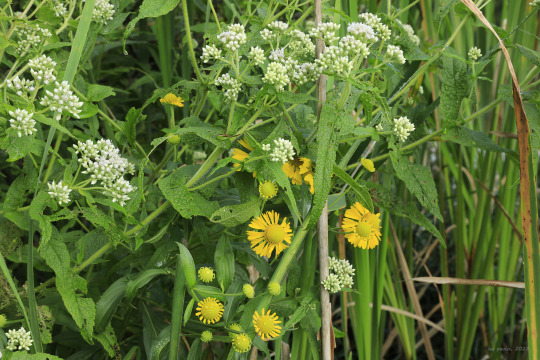




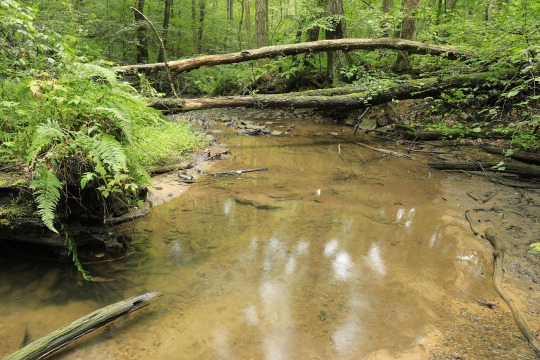


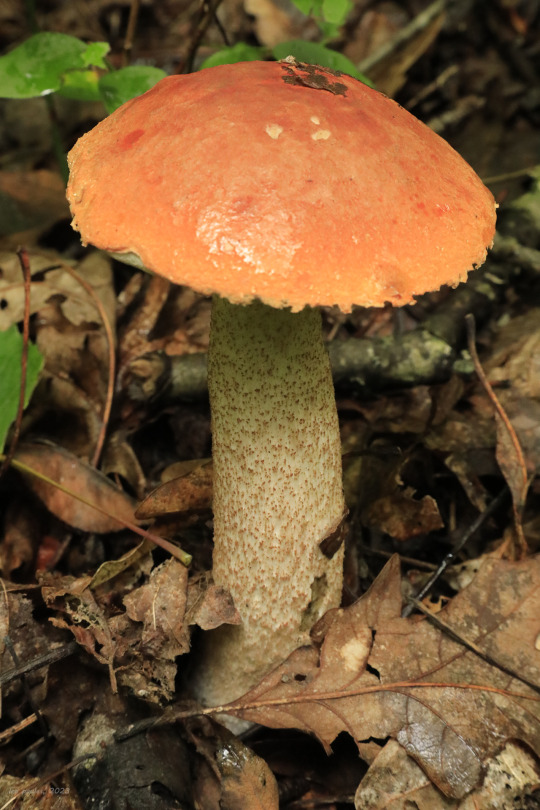
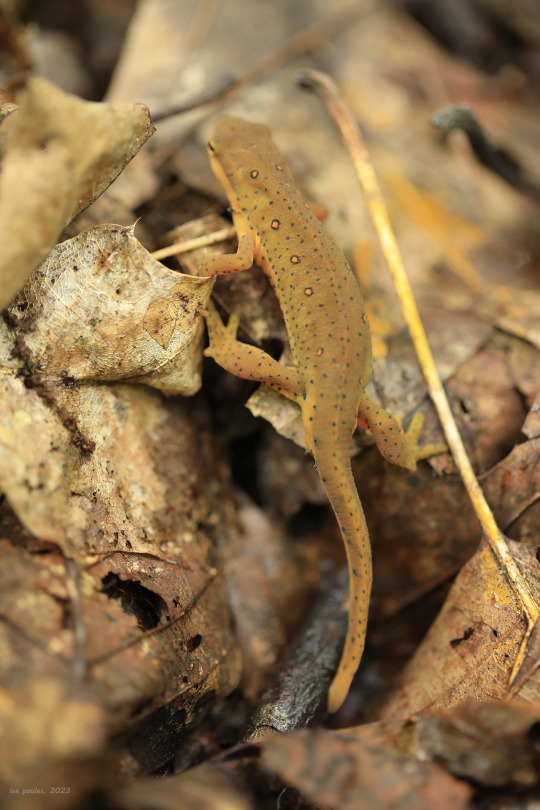


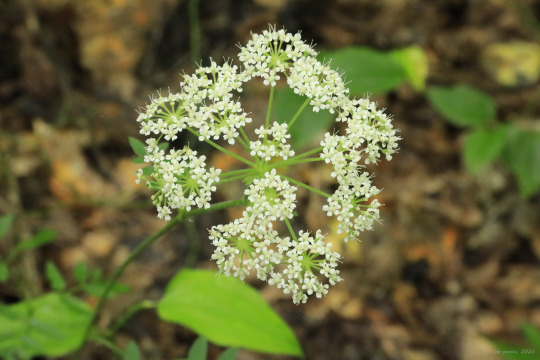


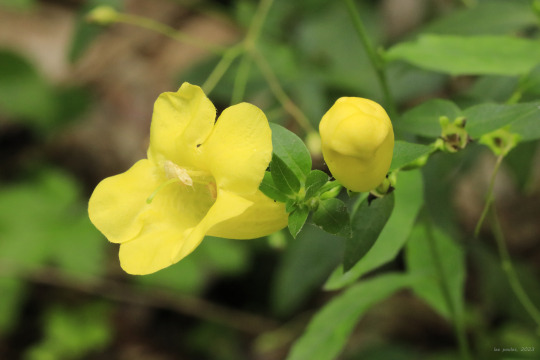

The one thing that excites me more than a pop-up summer thunderstorm is a walk in a damp, dripping, glowing-green forest after the storm has passed. The forest's living essence is made all the more real and immediate by the intoxicating perfume of decaying things, creatures flitting like ghosts through the leaves and underbrush, and clinging raindrops unleashed from the treetops by an evanescent breeze. Photos above are from a hike this morning on Glade Run Trail in Coopers Rock State Forest.
From top: common boneset (Eupatorium perfoliatum), which is closely related to Joe Pye weed, and sneezeweed (Helenium autumnale); the deep purple-red berries of common elderberry (Sambucus canadensis); hollow Joe Pye weed (Eupatorium fistulosum), which can attain a height of 7 to 8 feet; eastern tiger swallowtail (Papilio glaucus), whose tattered wings show the wear and tear of summer errands; a colony of gregarious fungi, perhaps cross-veined troop mushroom (Xeromphalina kauffmanii), which grow in huge numbers on decaying hardwoods; a red-capped bolete, perhaps Leccinum longicurvipes, which is symbiont with oak trees; an eastern newt (Notophthalmus viridescens); white wood aster (Eurybia divaricata); bigleaf aster (Eurybia macrophylla); cowbane (Oxypolis rigidior), also known as common water dropwort; bluestem goldenrod (Solidago caesia), a woodland goldenrod with flowerheads in the leaf axils; and Appalachian oak-leach (Aureolaria laevigata), also known as smooth false foxglove, which is semi-parasitic on oak tree roots.
#appalachia#vandalia#west virginia#wildflowers#flora#summer#coopers rock state forest#glade run trail#common boneset#sneezeweed#common elderberry#hollow joe pye weed#eastern tiger swallowtail#butterfly#lepidoptera#eastern newt#amphibian#fungi#bolete#white wood aster#bigleaf aster#cowbane#common water dropwort#bluestem goldenrod#blue-stemmed goldenrod#wreath goldenrod#appalachian oak-leach#smooth false foxglove
137 notes
·
View notes